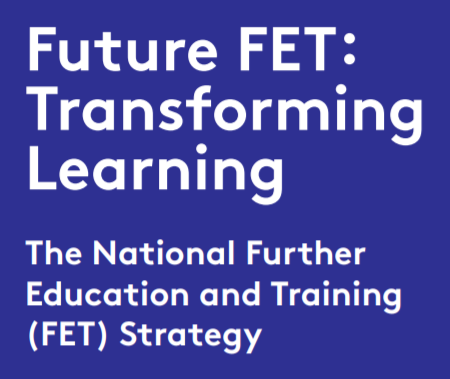The new national Further Education and Training (FET) Strategy Future FET: Transforming Learning was published on July 16th 2020 and launched by Minister for Further and Higher Education, Research, Innovation and Science Simon Harris TD and Minister of State for Further Education Niall Collins TD. This new FETS will cover the period 2020 to 2024.
In the Ministers’ press release it states “The strategy sets out a five-year roadmap for the sector which is built around three key pillars of building skills, fostering inclusion and creating pathways and aims to address the economic and societal challenges faced over the coming years.”
On page thirty of the Strategy it notes “A challenge that pervades FET planning is that of a sudden cyclical economic downturn. FET planning must ensure agility to respond to a large base of unemployed people, or very vulnerable workers in need of up-skilling and re-skilling to re-join or remain in the workforce. This need is currently exacerbated by Covid-19 and the serious potential economic risks of Brexit.”
Further on in the document it says “Of course, there is a short-term imperative for FET to lead the response to the critical up-skilling and re-skilling needs of those who have lost their jobs as a result of Covid-19.” (p43)
Building on the role and work of SOLAS and the Education and Training Boards alongside the Department of Employment Affairs and Social Protection’s Intreo service is noted as important in supporting people to improve their employment prospects.
In this regard the Strategy highlights three strands of FET provision: transversal skills development to help employability; building the digital capabilities now required for almost every job; and specific Level 4-6 courses targeting growth sectors and occupations.
An issue that INOU affiliates have raised is the lack of appropriate provision and challenges facing people, in particular young men, who would require FET provision at a lower level. To that end it is welcome that on page forty-seven of the Strategy it notes “There are many cohorts with diverse needs, such as people with disabilities, new migrants, Travellers, the long-term unemployed, ex-offenders and women returners. All these require focused types of support to address their particular circumstances and needs. For such groups, the FET system should adopt a more targeted approach to addressing barriers around participation, completion and progression for marginalised and prioritised cohorts. ETBs should work in partnership with community and voluntary organisations who can represent or reach out to particular groups and facilitate a pathway to re-engage with education through FET.”
However, it will be really important to ensure that at the same time real opportunities for this cohort of learners to gain access to a decent job are not only created but maintained and developed.
It is also welcome that on page forty-five of the Strategy it states that “Active inclusion and community development have always been a central tenet of the work of ETBs and FET providers, with an extensive reach into and across local communities.”
And later on the same page, “Community education plays a critical role in this regard, supporting participation and re-engagement in education and training, with around 50,000 learners across FET each year. An extensive network of community education providers work in partnership with ETBs, using their local reach and connectivity to develop learning projects to address local needs and empower their learners and communities.”
The FETS notes the need to strive over the next five years for a consistency of approach to learner supports which can vary quite a bit across the full range of provision. Amongst the inconsistencies highlighted are the “financial support provided to the learner depending on the FET course on which they are enrolled. For example, if a learner is on a Level 5 PLC course, they can avail of a SUSI support grant in the same way as an HE student, but if the learner wants to do a Level 5 traineeship, they must sign on as unemployed to receive a training allowance.” As the Strategy rightly states this is a cross Government / Departmental issue, but it goes to say that “a common cross-FET student financial support system must be a major goal in achieving a clear and coherent learner support structure for the system.” (p45)
If you wish to read Future FET: Transforming Learning please follow this link: https://www.solas.ie/f/70398/x/64d0718c9e/solas_fet_strategy_web.pdf
